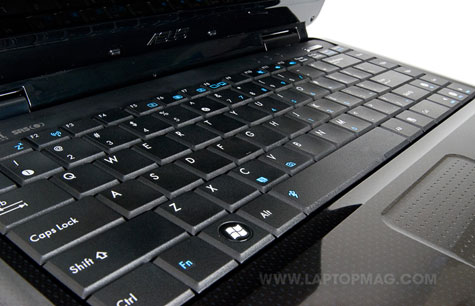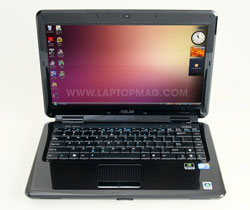Laptop Mag Verdict
This 14-inch notebook boasts a sleek design and good graphics punch for the price.
Pros
- +
Attractive design
- +
Above-average graphics performance
- +
Strong Wi-Fi range
- +
Two-year warranty
Cons
- -
Keyboard has some flex
- -
Low volume
- -
No HDMI port
Why you can trust Laptop Mag
It wasn't that long ago that you had to spend at least a grand to get a lightweight notebook with discrete graphics. The ASUS K40 (IN-B1), a 14-inch machine that sports an Nvidia GPU, is priced at at an aggressive $799, making it a good choice for students. This system also features an attractive design, strong Wi-Fi performance, and a generous two-year warranty. The lack of HDMI output and relatively low speaker volume may give some pause, but overall the K40 is a good value.
Design
The first thing you'll notice about the 13.6 X 9.8 X 1.4-inch K40 is its attractive lid; it features a black finish with a subtle blue dot pattern. Upon lifting the lid, you'll notice that the finish extends to the base of the system (except for the strip directly north of the keyboard) for a unified look. As with other glossy notebooks, the K40 collects fingerprints and smudges, but those can be easily remedied with a quick wipe. At 5.2 pounds, the system is quite totable, but is a bit heavier than similar notebooks. The Lenovo IdeaPad Y450, for example, weighs just 4.6 pounds.
Keyboard and Touchpad
E-mailing friends and crafting Word documents was a breeze, thanks to the K40's spacious base and roomy palm rest area. The keyboard, however, could use some work; not only does its left portion have a significant amount of flex, but the keys themselves had a somewhat hollow feel. On the plus side, a number of keys have special blue characters that allow you to launch programs when used in conjunction with the Fn key. Pressing Fn + space bar, for example, lets you cycle through power settings; Fn + F1 puts the system to sleep. It's a nice way to quickly accomplish simple tasks.

Click to enlarge
Below the keyboard is a slightly textured touchpad that let us swiftly move the cursor across the desktop. The mouse buttons (much like the keyboard) felt mushy, and didn't offer much in the way of feedback.
Display and Audio
Our Iron Man DVD looked good on the K40's 14-inch (1366 x 768) display. The reds and golds in Tony Stark's armor really popped, and night scenes had a suitable amount of darkness without overwhelming the visuals. The LCD's 16:9 aspect ratio means that the black bars at the top and bottom of the screen are smaller than usual while watching widescreen movies. Like many glossy displays, the K40's screen kicks back reflections, which minimizes viewing angles.
A pair of Altec Lansing speakers with SRS audio boosting technology delivered good audio quality. Kool & The Gang's "Too Hot" had a nice balance of highs and lows, and the audio had a very warm feeling throughout. The only downside is that the speakers could benefit from a higher maximum volume; the audio wasn't loud enough to fill a medium-sized conference room.
Ports and Webcam
The right side of the K40 features two USB 2.0 ports, VGA, Ethernet, and headphone and microphone jacks; its left side houses two additional USB 2.0 ports, and an 8X DVDRW drive. The back of the system contains two Kensington lock slots, while the front has a 3-in-1 memory card reader. Unfortunately, the machine lacks an HDMI port for delivering a 1080p image via a single cord to a high-resolution monitor or TV. This omission is surprising given that the K40's Nvidia GeForce G102M GPU is more than capable of exporting HD video.
The 1.3-megapixel webcam served up accurate colors and lifelike skin tones in both bright and low light when we chatted with friends using Meebo. Buddies reported that both the audio and visuals were good, but there was some motion blur when we moved quickly. We liked that we could take still photos ranging in resolution from 160 x 120 up to 1280 x 1024 pixels, and video with resolutions escalating from 160 x 120 to 640 x 480 pixels. The LifeFrame software allowed us to add Black & White, Sepia, and several other effects.
CPU and Hard Drive Performance
The combination of a 2.1-GHz Intel Core 2 Duo T6500 CPU and 4GB of RAM allowed the K40 to perform decently on our benchmarks. It notched a score of 3,088 on PCMark Vantage (a Windows Vista performance benchmark), which is slightly higher than the thin-and-light notebook category average (3,048). This score also beats the HP Pavilion dv4t (2,804) and the Gateway TC7804u (2,471), but it's about 450 points less than the Dell Studio 14z (3,544). Windows and menus opened near instantaneously, but Windows Media Player lagged a bit when opening; it took 9.2 seconds to fully load The Posies' "I Guess You're Right" WMA file.
Fortunately, the 5,400-rpm, 320GB hard drive fared a bit better. It managed to duplicate a 4.97GB folder of mixed media at a rate of 19.1 MBps, which was right between the 19.6 MBps category average and the Dell Studio 14z's 18.5 MBps. The drive enabled the Windows Vista Home Premium operating system to boot in 1 minute and 6 seconds, which is 6 seconds longer than the average and 10 seconds longer than the Dell Studio 14z.
Graphics and CUDA Performance
The discrete Nvidia GeForce G102M GPU (with 512MB of video memory) powered the K40 to a 3DMark06 score of 1,588; that's below the Dell Studio 14z's mark of 2,101 (which has an Nvidia GeForce 9400M card), but just above the 1,479 category average. The K40 also smoked the integrated graphics of the Gateway TC7804u (which scored 912) and the HP Pavilion dv4t (776).
We saw the K40 push polygons at a solid 25 frames per second when playing Far Cry 2 at its 1024 x 768 autodetect mode. Unfortunately, the frame rate plummeted when we cranked the resolution up to 1366 x 768; the game chugged along an unplayable 7 fps. The Dell Studio 14z saw similar scores of 26 and 11 fps.
The K40 was more than capable of playing a high-definition (1080p) 1-minute-and-31-second Storm Chasers clip without a hiccup; there was no stuttering as an airplane circled through a series of clouds.
When we converted a 114MB MPEG-4 video file to AVI using Handbrake, the K40 took 7 minutes and 31 seconds to complete the task (just a second longer than the Dell Studio 14z), which was a bit behind the 6:57 category average. Using vReveal, a CUDA application that takes advantage of the system's Nvidia graphics card to help in the transcoding process, the same test took just 3 minutes and 31 seconds, which was only 11 seconds slower than the 14z. This clearly illustrates the amount of extra power discrete graphics can bring to a PC.
Wi-Fi and Battery Life
The 802.11a/b/g/n Wi-Fi radio inside the K40 pushed data along at a rate of 25.5 Mbps when the notebook was placed 15 feet away from our access point, and 17.4 Mbps at 50 feet away. These numbers are both higher than the category averages of 19.6 Mbps and 15.5 Mbps. We streamed a high-definition episode of Dr. Horrible's Sing-Along Blog without any audio/video stuttering.
On our LAPTOP Battery Test, the K40 lasted 3 hours and 51 minutes, which is 23 minutes shorter than the average thin-and-light, and 1:44 shorter than the Dell Studio 14z's runtime (although that system uses an eight-cell battery). However, the K40 bested the Gateway TC7804u (3:20) and HP Pavilion dv4t (3:08), and is on a par with the Lenovo IdeaPad Y450's endurance.
Green Testing
It took 2 hours and 12 minutes to fully recharge the K40's battery; during that time, the notebook used an average of 46.2 watts. For the LAPTOP Battery Efficiency Rating (the total amount of watts it takes to recharge divided by the battery life), the system returned a score of 26.4 watts per minute of battery life, the same as the Dell Studio 14z, and about 2 watts lower than the thin-and-light average (the lower the score, the better).
Other Configurations

Click to enlarge
Also available is the $699 ASUS K40IJ, which sports the same specs as this unit, though it instead features an integrated Intel GL40 graphics chip and 250GB of storage.
Software and Warranty
Bundled software includes Adobe Reader 9, Google Picasa 3, LifeFrame (for adding visual effects to webcam images), and Norton Internet Security (90-day trial). ASUS covers the K40 with a two-year global warranty with such extras as one year of accidental damage coverage, 30-Day Zero Bright Dot, two-way free standard overnight shipping, and 24/7 tech support. If you're curious about the quality of ASUS' support, check out how it fared in our annual Tech Support Showdown.
Verdict
Priced at $799, the ASUS K40 (IN-B1) costs more than your typical 14-inch notebook, but it's worth the premium if you're looking for better graphics performance. If you can do without a DVD drive and you want longer battery life, go for the $749 Dell Studio 14z, which also has discrete Nvidia graphics. But if you prefer to have an optical drive, the ASUS K40 is a solid pick.
ASUS K40 Specs
| Brand | ASUS |
| CPU | 2.1-GHz Intel Core 2 Duo T6500 |
| Card Slots | 3-1 card reader |
| Company Website | http://usa.asus.com |
| Display Size | 14 |
| Graphics Card | Nvidia GeForce G102M |
| Hard Drive Size | 320GB |
| Hard Drive Speed | 5,400rpm |
| Native Resolution | 1366x768 |
| Operating System | MS Windows Vista Home Premium (32-bit) |
| Optical Drive | DVD /-RW |
| Optical Drive Speed | 8X |
| Ports (excluding USB) | Microphone, Kensington Lock, Headphone, Ethernet, VGA |
| RAM | 4GB |
| RAM Upgradable to | 4GB |
| Size | 13.6 x 9.8 x 1.4 |
| USB Ports | 4 |
| Video Memory | 512MB |
| Warranty/Support | Two-year global, one-year accidental, 30-Day Zero Bright Dot/24/7 toll-free phone |
| Weight | 5.2 pounds |
| Wi-Fi | 802.11a/b/g/n |
Jeffrey is a writer at Laptop Mag. His coverage includes chiefly laptop reviews, and he's tried some of the top brands out there, including Acer, Lenovo, MSI, Dell, and Sony. Outside of digging into laptop performance and features, Jeffrey covers things like peripherals and software.
